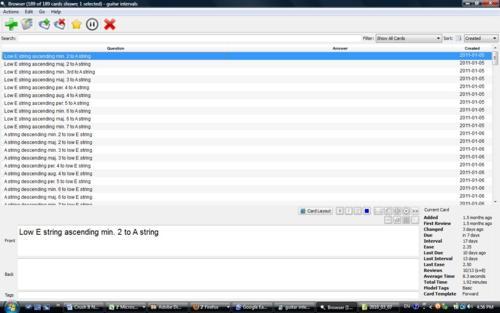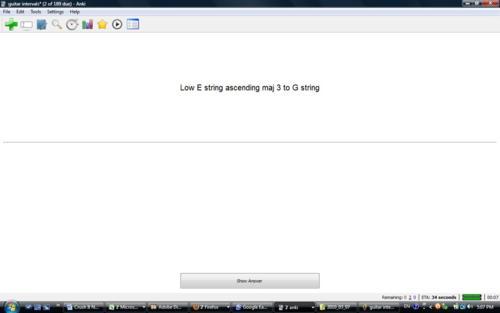I used to try to keep a detailed paper log of my practice sessions on guitar. My poor handwriting deterred me from referring back to them and I often gave up and started again. Then, I decided that a blog would be a good motivator for me. More recently, thanks to reading Gary Vaynerchuk's Crush It, I realized that a blog would be the perfect platform to document my quest to become a good guitar player.
A little less than a year ago, I had a crisis in my relationships towards music. I had massacred a piece that I loved (Rick Foster arrangement of Swing Low, Sweet Chariot) at a gig in Japan. It was technically a bit beyond my level and I blanked while playing from memory. I had such great support from my friends at that concert:

So I felt guilty after the concert. I hit Amazon for books to help and bought Gerald Klickstein’s The Musician’s Way. This book has helped me in my musical journey tremendously.
The first thing Klickstein talks about is dividing practice material into 5 zones. So it is important to practice concert-ready material, developing material, technique and then what he calls musicianship (sight-reading and improvisation).
I’ve known for quite some time that if I focus only on material that’s ready, other aspects will suffer. The problem is consistently practicing material in the 5 zones.
Among the many things I am interested in is samba and bossa nova. These styles, like jazz, rely heavily on 4-part and altered chords. These chords are beautiful!
The traditional approach to learning these chords has been to memorize their patterns on the fretboard. I’ve been able to memorize the most heavily-used chords like this (ex. CMaj7), but no more.
So, I decided that I need to learn the interval relationships between the notes on the guitar. As in, what interval is between the low E string and the open B string?
Before studying Japanese characters (kanji), I would probably have made physical flashcards. Probably, I would have gotten lazy or become overwhelmed by managing the reviews.
Thank god for the computer nerds! Almost two years ago, searching for a way to re-learn kanji that I had learned while I was studying abroad in Japan, I happened upon a spaced-repetition-software site. Later, I switched to using a program called Anki based on the same principle.
Hundreds of hours of studying and thousands of stories about kanji later, I’ve now experienced how my brain transfers information from the short-term to long-term memory.
So, I decided that I would create a deck of intervals on the guitar in Anki. Here’s a screenshot of a list of the flashcards.

If you’re familiar with Anki, you may notice that my answer side of the flashcard is empty. That’s because I have my guitar on when I’m doing the reviews, and I simply play the interval when it pops up in Anki.

I typically review the cards daily and add new ones if I did well on my reviews. Since I started doing this on January 5, 2011, I have made 189 cards.
I have experienced the usefulness of this approach by being able to identify intervals between notes as I’m picking out a tune.
One of my musicianship goals is to be able to sight-read intermediate pieces. So, I look forward to the day when I’ve got all the intervals in Anki and can move on to studying triads in earnest.
A little less than a year ago, I had a crisis in my relationships towards music. I had massacred a piece that I loved (Rick Foster arrangement of Swing Low, Sweet Chariot) at a gig in Japan. It was technically a bit beyond my level and I blanked while playing from memory. I had such great support from my friends at that concert:

So I felt guilty after the concert. I hit Amazon for books to help and bought Gerald Klickstein’s The Musician’s Way. This book has helped me in my musical journey tremendously.
The first thing Klickstein talks about is dividing practice material into 5 zones. So it is important to practice concert-ready material, developing material, technique and then what he calls musicianship (sight-reading and improvisation).
I’ve known for quite some time that if I focus only on material that’s ready, other aspects will suffer. The problem is consistently practicing material in the 5 zones.
Among the many things I am interested in is samba and bossa nova. These styles, like jazz, rely heavily on 4-part and altered chords. These chords are beautiful!
The traditional approach to learning these chords has been to memorize their patterns on the fretboard. I’ve been able to memorize the most heavily-used chords like this (ex. CMaj7), but no more.
So, I decided that I need to learn the interval relationships between the notes on the guitar. As in, what interval is between the low E string and the open B string?
Before studying Japanese characters (kanji), I would probably have made physical flashcards. Probably, I would have gotten lazy or become overwhelmed by managing the reviews.
Thank god for the computer nerds! Almost two years ago, searching for a way to re-learn kanji that I had learned while I was studying abroad in Japan, I happened upon a spaced-repetition-software site. Later, I switched to using a program called Anki based on the same principle.
Hundreds of hours of studying and thousands of stories about kanji later, I’ve now experienced how my brain transfers information from the short-term to long-term memory.
So, I decided that I would create a deck of intervals on the guitar in Anki. Here’s a screenshot of a list of the flashcards.

If you’re familiar with Anki, you may notice that my answer side of the flashcard is empty. That’s because I have my guitar on when I’m doing the reviews, and I simply play the interval when it pops up in Anki.

I typically review the cards daily and add new ones if I did well on my reviews. Since I started doing this on January 5, 2011, I have made 189 cards.
I have experienced the usefulness of this approach by being able to identify intervals between notes as I’m picking out a tune.
One of my musicianship goals is to be able to sight-read intermediate pieces. So, I look forward to the day when I’ve got all the intervals in Anki and can move on to studying triads in earnest.